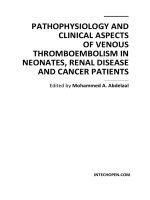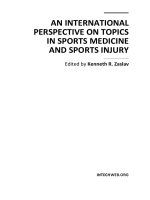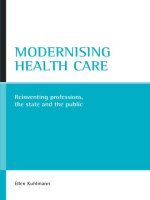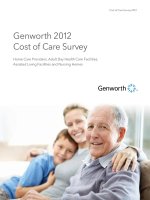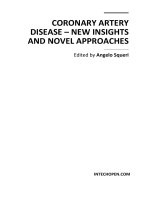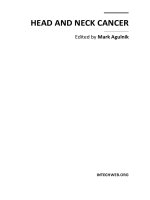Oral Health Care – Prosthodontics, Periodontology, Biology, Research and Systemic Conditions Edited by Mandeep Singh Virdi pdf
Bạn đang xem bản rút gọn của tài liệu. Xem và tải ngay bản đầy đủ của tài liệu tại đây (20.46 MB, 382 trang )
ORAL HEALTH CARE –
PROSTHODONTICS,
PERIODONTOLOGY,
BIOLOGY, RESEARCH AND
SYSTEMIC CONDITIONS
Edited by Mandeep Singh Virdi
Oral Health Care – Prosthodontics, Periodontology, Biology, Research
and Systemic Conditions
Edited by Mandeep Singh Virdi
Published by InTech
Janeza Trdine 9, 51000 Rijeka, Croatia
Copyright © 2012 InTech
All chapters are Open Access distributed under the Creative Commons Attribution 3.0
license, which allows users to download, copy and build upon published articles even for
commercial purposes, as long as the author and publisher are properly credited, which
ensures maximum dissemination and a wider impact of our publications. After this work
has been published by InTech, authors have the right to republish it, in whole or part, in
any publication of which they are the author, and to make other personal use of the
work. Any republication, referencing or personal use of the work must explicitly identify
the original source.
As for readers, this license allows users to download, copy and build upon published
chapters even for commercial purposes, as long as the author and publisher are properly
credited, which ensures maximum dissemination and a wider impact of our publications.
Notice
Statements and opinions expressed in the chapters are these of the individual contributors
and not necessarily those of the editors or publisher. No responsibility is accepted for the
accuracy of information contained in the published chapters. The publisher assumes no
responsibility for any damage or injury to persons or property arising out of the use of any
materials, instructions, methods or ideas contained in the book.
Publishing Process Manager Irena Voric
Technical Editor Teodora Smiljanic
Cover Designer InTech Design Team
First published February, 2012
Printed in Croatia
A free online edition of this book is available at www.intechopen.com
Additional hard copies can be obtained from
Oral Health Care – Prosthodontics, Periodontology, Biology, Research and Systemic
Conditions, Edited by Mandeep Singh Virdi
p. cm.
ISBN 978-953-51-0040-9
Contents
Preface IX
Part 1 Geriatric Dentistry and Prosthodontics 1
Chapter 1 Relationship Between Chewing and Swallowing Functions
and Health-Related Quality of Life 3
Hiroko Miura, Shuichi Hara, Kiyoko Yamasaki and Yoshie Usui
Chapter 2 Residual Ridge Resorption – Revisited 15
Derek D’Souza
Chapter 3 Improvement of Patient’s Satisfaction and
Oral Health-Related Quality of Life by the Implant and
Prosthodontic Treatment 25
Nikola Petricevic, Asja Celebic and Ksenija Rener-Sitar
Chapter 4 Association Between Tooth Loss
and Cancer Mortality in Elderly Individuals 53
Toshihiro Ansai and Yutaka Takata
Chapter 5 Geriatric Oral Health – Appreciating and
Addressing It with a Team Approach 67
Mun Loke Wong and Hilary P. Thean
Chapter 6 Research and Clinical Applications
of Facial Analysis in Dentistry 77
Barbara de Lima Lucas, Roberto Bernardino Júnior,
Luiz Carlos Gonçalves, Maria Beatriz Duarte Gavião
and Vanderlei Luiz Gomes
Part 2 Periodontology and Oral Biology 95
Chapter 7 Clinical and Histological Evaluation of
Barberry Gel on Periodontal Inflammation 97
Abbas Makarem, Amir Moeintaghavi, Hossein Orafaei,
Mahboube Shabzendedar and Iman Parissay
VI Contents
Chapter 8 Periodontal Disease and Carotid Atherosclerosis:
Mechanisms of the Association 109
Maria Serena De Franceschi, Leonzio Fortunato, Claudio Carallo,
Cesare Tripolino, Concetta Irace, Michele Figliuzzi,
Antonio Crispino and Agostino Gnasso
Chapter 9 Relationship Between
Oral Malodor and Oral Microbiota 121
Nao Suzuki, Masahiro Yoneda and Takao Hirofuji
Chapter 10 Oral Health and Nutrition 131
Sudeshni Naidoo
Chapter 11 Use of Polyols in Oral Biology Research 143
Kauko K. Mäkinen
Chapter 12 Virulence Mechanisms of Leukotoxin from
Aggregatibacter actinomycetemcomitans 165
Anders Johansson and Sotos Kalfas
Chapter 13 Transformation of Nitrite and Nitric Oxide
Produced by Oral Bacteria to Reactive Nitrogen Oxide
Species in the Oral Cavity 193
Umeo Takahama and Sachiko Hirota
Part 3 Research in Oral Health and Systemic Conditions 205
Chapter 14 Dentists and Preventive Oral Health Care 207
Hadi Ghasemi
Chapter 15 Inequality of Oral Health in a Life-Course Perspective 233
Dorthe Holst and Annemarie A. Schuller
Chapter 16 The Role of the Oral Health Therapist in the Provision
of Oral Health Care to Patients Across All Ages 249
Hanny Calache and Matthew Hopcraft
Chapter 17 Oral Health & HIV 271
Sudeshni Naidoo
Chapter 18 Oral Health of People with Psychiatric Disorders 287
Lin-Yang Chi and Kuan-Yu Chu
Chapter 19 Structural Changes on Human Dental Enamel
Treated with Er:YAG, CO
2
Lasers and
Remineralizing Solution: EDS Analysis 299
Rosalía Contreras-Bulnes, Oscar Fernando Olea-Mejía,
Laura Emma Rodríguez-Vilchis, Rogelio José Scougall-Vilchis
and Claudia Centeno-Pedraza
Contents VII
Chapter 20 Indigenous Australians and Oral Health 319
Madeline Shearer and Lisa Jamieson
Chapter 21 Oral Health Knowledge, Attitude
and Practices of Parents/Caregivers 341
Suttatip Kamolmatyakul
Chapter 22 Systemic Methods of Fluoride
and the Risk for Dental Fluorosis 357
Consuelo Fernanda Macedo de Souza, José Ferreira Lima Júnior,
Maria Soraya P. Franco Adriano and Fabio Correia Sampaio
Preface
Oral Health Care, commonly referred to as Dentistry, is the branch of medicine that is
involved in the study, diagnosis, prevention, and treatment of diseases, disorders, and
conditions of the oral cavity, maxillofacial area, and the adjacent and associated
structures, and their impact on the human body. Oral Health Care is considered
necessary for overall health.
The present work is a companion book of Oral Health Care - Pediatric, Research,
Epidemiology and Clinical Practices and is aimed at completing the whole range of
Oral Health Care. These books are using the internet, information technology’s most
potent tool, for its storage, retrieval, and dissemination amongst its target audience of
general practitioners, academicians, and research scholars of Oral Health Care Sciences
and Practices.
InTech-Open Access Publisher took the initiative in organizing the publication of this
book and its companion book, and to make it available on the internet with free access
to all those who may be interested in the subject.
The book has contributions from specialists in various subjects of Oral Health Sciences,
and is divided into four chapters, namely geriatric dentistry and prosthodontics,
periodontology and oral biology, research in oral health, and systemic conditions.
We expect the present work to be accepted as a reference material and initiator of
research in the areas covered, as it traces developments on the specific issues and
reflects the trend of current research.
The editor wishes to thank all specialist contributors and Publishing Process Manager
Ms Irena Voric of InTech for their contributions without which this book would not
have been possible. It will not be out of place to acknowledge with gratitude the
contribution of my family, who were kind enough to bear with me during the process
of developing this book.
Mandeep Singh Virdi
Department of Preventive and Pediatric Dentistry,
PDM Dental College and Research Institute, Bahadurgarh, HR
India
Part 1
Geriatric Dentistry and Prosthodontics
1
Relationship Between Chewing and Swallowing
Functions and Health-Related Quality of Life
Hiroko Miura
1
, Shuichi Hara
2
, Kiyoko Yamasaki
2
and Yoshie Usui
1
1
Area on Community Healthcare, National Institute of Public Health,
2
Kyushu University of Health and Welfare
Japan
1. Introduction
Population aging has advanced rapidly in developed countries. In particular, Japan has
already become a “Super Aging Society” (MHLW, 2010), and this trend exists in other Asian
countries such as South Korea as well (Fig. 1). The increase in life expectancy has led to a
decreased ratio between people of working-age and older individuals. At present, the aging
problem is most common in developed and mid-developed countries.
During the last 6 decades, the types of diseases found in Japan have changed greatly with
socio-economic development (Matsuda, 2008). For example, the present major causes of
death in Japan are non-communicable diseases (NCD) such as malignant neoplasm,
cardiovascular disease, and cerebrovascular disease (WHO, 2011). With an aging
population, the need for geriatric dentistry has increased greatly in Japan. Oral health is
important in the elderly; it helps maintain the ability to chew, swallow, and speak clearly,
which are important for quality of life (QOL) (Pereira et al., 2006; Sonies et al., 1984).
Fig. 1. Percentage of elderly people in the population of 7 countries, including Japan
Year
%
Oral Health Care – Prosthodontics, Periodontology, Biology, Research and Systemic Conditions
4
1.1 QOL improvement and successful aging
Psychosocial approaches to successful aging focus on high social functioning and life
satisfaction (Britton et al., 2008; Peel et al., 2005). In particular, sustaining good health is
essential for maintaining QOL. Health-related QOL (HRQOL) refers to the perception of
overall satisfaction with life and involves the measurement of functional status in the
physical, mental, and social realms (Coons et al., 2000). Successful aging is a key concept for
improving the quality of life. Application of this broader perspective helps to explain why
dental treatment of elderly individuals is more likely to succeed if it addresses oral
problems that disturb self-image and social interactions, rather than an approach based
solely on function.
Previous studies have reported that QOL is closely related to health and financial status
(Robert et al., 2009; Yamazaki et al., 2005), and maintaining satisfactory health, in particular,
is essential to successful aging. Thus, HRQOL is a key issue for the elderly.
1.2 Evaluation of HRQOL
Previous studies reported different methods for evaluating HRQOL. Representative
evaluation methods are SF-36 (Brazier et al., 1992), SF-8 (Ware et al., 2001), Sickness Impact
Profile (Berger, 1981), WHOQOL-BREF (WHO, 2011), and EuroQOL (EuroQOL Group,
1990). In particular, SF-36 and SF-8 have been translated into many languages, including
Japanese. More specific evaluations, for example, are EROTC QLQ for cancer (Asronzon et
al., 1993), KDQOL (Hays, 1994) for kidney disease, and GOHAI for oral health (Atchinson et
al., 1990) . These methods are also very useful for assessing comprehensive health status
among the elderly.
1.3 Geriatric oral health in Japan
In Health Japan 21, a national health campaign to improve the population’s health status,
the followings were identified as focus areas: nutrition, physical activity, mental health,
tobacco control, alcohol control, oral health, diabetes control, prevention of heart diseases,
and prevention of cancer (MHLW, 2011). Oral health goals in Health Japan 21 were as
follows: (1) prevention of dental caries among infants, (2) prevention of dental caries at
school age, (3) prevention of periodontal disease, and (4) prevention of tooth loss. The
“prevention of tooth loss” is particularly important for the oral health of aging people.
Table 1 shows baseline and intermediate oral health results after 5 years of the Health Japan
21 initiative. The goals relevant to the elderly are to increase the percentage of: 80-year-olds
retaining 20 or more teeth; 60-year-olds retaining 24 or more teeth; the increased numbers of
people receiving tooth scaling and cleaning; and the increased number of individuals
receiving a periodontal checkup. According to the intermediate report (Ministry of Health,
Labour, and Welfare, 2007), the dentition of the elderly has greatly improved. Figure 2
shows the national data regarding the percentage of individuals retaining more than 20
teeth. In Japan, the “8020 movement,” which means to keep 20 teeth at 80 years, has already
been a very popular oral health initiative (Shinsho 2001).
1.4 Oral health and overall health
The oral cavity is important for its eating and speaking functions; eating is necessary for
survival, and speaking is essential for satisfactory verbal communication. Many
epidemiological studies have shown that good oral health contributes to greatly improving
Relationship Between Chewing and Swallowing Functions and Health-Related Quality of Life
5
the physical health of community-dwelling elderly individuals in Japan (Miura et al., 1997;
Miura et al., 1998; Miura et al., 2005; Moriya et al., 2011). The scientific evidence contained in
these studies provides a useful guidance to other mid-developed countries.
Goals
Age of target
population
Percent of population
Baseline Mid-term Final target
Increase of the proportion of
persons with 20 or more teeth
80 11.5% 25.0% >20%
Increase of the proportion of
persons with 24 or more teeth
60 44.1% 60.2% >50%
Increase of the proportion of
persons with dental scaling
each year
60 15.9% 43.2% >30%
Increase of the proportion of
persons with periodontal
checkup each year
60 16.4% 35.7% >30%
Table 1. Mid-term evaluation of the oral health initiative goals in 2006 from Health Japan 21
for the prevention of tooth loss
Fig. 2. Persons retaining 20 or more teeth from 1987 to 2005 in Japan (MHLW, 2006)
Chewing and swallowing disorders are prevalent in frail elderly people. In particular,
masticatory problems in the disabled elderly are frequently related to tooth loss and ill-
fitting dentures. Mastication is necessary for the reduction of food mass, and therefore,
inadequate chewing may cause dysphagia symptoms, particularly in the elderly. Several
cross-sectional studies revealed that preservation of a person’s ability to chew contributed
Oral Health Care – Prosthodontics, Periodontology, Biology, Research and Systemic Conditions
6
greatly, not only to physical health, but to QOL as well (Miura et al., 2000; Mori et al., 2010).
Furthermore, subsequent studies provided a new perspective for assessing the HRQOL of
subjects who suffer from systemic disease with oral symptoms or dysfunction; whereas
dysphagia may be the functional focus, patients with dysphagia often have inadequate diets
that also produce systemic problems (Foley et al., 2009).
Eating is a pleasure for most people in daily life; therefore, the relationship between
improvement in dysphagia and QOL, especially for the elderly, is an important issue.
Because consumption of food and drinks form integral to social events and symbolize
acceptance, friendship, and community, it is not surprising that swallowing problems evoke
a host of distressing psychosocial responses, such as anxiety, shame, embarrassment, fear,
and lowered self-esteem (McHorney et al., 2000).
1.5 Purpose of the present study
A decline in chewing and swallowing functions among the elderly is closely related to an
increase in overall health risks, such as malnutrition and aspiration pneumonia. Insufficient
chewing and swallowing functions could result in a lower HRQOL. In this chapter, we
report on our field survey on the relationship between chewing, swallowing, and HRQOL in
the elderly.
2. Subjects and methods
2.1 Subjects
The cross-sectional survey was conducted from September 2010 to January 2011 in the
northern area of Miyazaki Prefecture, located in Southern Japan. Our initial target sample
was 675 community-dwelling individuals who were older than 65 years. Before the survey,
we explained in detail the intent of the present survey and obtained informed consent from
541 persons (response rate = 80.1%). The present study was approved by the Institutional
Review Board of National Institute of Public Health of Japan.
2.2 Measurements
The respondents were asked to complete a structured questionnaire regarding the following
items: (i) demographic variables, (ii) dysphagia risk, (iii) HRQOL, and (iv) overall
satisfaction with diet. The decline in the ability to chew and swallow was assessed using the
dysphagia risk assessment for the community-dwelling elderly (DRACE), which was
developed by Miura et al. (2006). Table 2 shows the assessment items of DRACE. Dysphagia
risk was determined according to the criteria of our previous study (Miura et al., 2007); thus,
subjects who had >2 positive scores on DRACE were classified as at risk for dysphagia.
HRQOL among community-dwelling elderly people was evaluated using the Japanese
version of the SF-8 Health Survey (Fukuhara et al., 2004). The SF-8 represents a major
advance in the application of SF technology for purposes of achieving both brevity and
comprehensiveness in population health surveys. The SF-8 is widely used to assess QOL,
including health status, and comprises the following 8 health subsets: physical functioning
(PF), role physical (RP), body pain (BP), general health (GH), vitality (VT), social functioning
(SF), role emotional (RE), and mental health (MH). Levels of subjective satisfaction with diet
were measured by the question: “Are you satisfied with your present diet?” Subjects
categorized themselves by using the 5 Likert scale.
Relationship Between Chewing and Swallowing Functions and Health-Related Quality of Life
7
The following questions are related to your ability to swallow food and beverages.
Please select the option that best describes your experience in the last year.
(1) Have you had at least one episode of fever?
2 Frequently 1 Occasionally 0 Never
(2) Have you felt that you take a longer time to eat than before?
2 Much longer 1 Slightly longer 0 Not at all
(3) Have you had difficulties with swallowing beverages?
2 Frequently 1 Occasionally 0 Never
(4) Have you had difficulties with chewing hard food?
2 Frequently 1 Occasionally 0 Never
(5) Have you experienced food spilling out of your mouth?
2 Frequently 1 Occasionally 0 Never
(6) Have you ever choked while eating?
2 Frequently 1 Occasionally 0 Never
(7) Have you ever choked while drinking beverages?
2 Frequently 1 Occasionally 0 Never
(8) Have you ever swallowed food and had it go up your nose?
2 Frequently 1 Occasionally 0 Never
(9) Have you ever had a change in your voice after a meal?
2 Frequently 1 Occasionally 0 Never
(10) Have you ever produced sputum during a meal?
2 Frequently 1 Occasionally 0 Never
(11) Have you ever felt like you had a lump in your throat while swallowing?
2 Frequently 1 Occasionally 0 Never
(12) Have you ever had food or liquid from your stomach come back up into your throat?
2 Frequently 1 Occasionally 0 Never
Table 2. Dysphagia risk assessment for community-dwelling elderly (DRACE)
2.3 Analyses
Bivariate analyses were performed using Pearson correlation coefficients, and partial
correlation coefficients were determined to control typical demographic variables such as
age and gender. Then, a stepwise multiple regression was performed with the DRACE score
treated as the dependent variable for each independent variable (F = 2.5) in order to detect
the factors with the largest influence on the risk of dysphagia among the elderly. All
statistical procedures were performed using SPSS ver.18.0 (Chicago, IL, USA).
3. Results
3.1 Univariate analysis
Table 3 shows the characteristics of the elderly subjects, DRACE scores, and SF-8 mean
value and standard deviation. Each of the SF-8 sub-scores was similar to the standardized
Oral Health Care – Prosthodontics, Periodontology, Biology, Research and Systemic Conditions
8
value of Japanese elderly population. The distribution of DRACE scores among the
respondents is shown in Figure. 3. In the present survey, 45.0% of individuals had
dysphagia risk.
Satisfaction with diet Frequency (%)
Very satisfied 59.9
Satisfied 33.4
Fair 5.1
Unsatisfied 0.9
Very unsatisfied 0.3
(a)
Variable Mean SD Median
Age 76.06 6.75 75.00
DRACE score 3.02 2.09 2.00
SF-8 sub scores
PF 48.48 6.32 48.52
RP 48.06 7.36 48.47
BP 46.43 7.97 46.19
GH 49.41 6.71 50.71
VT 49.87 6.48 54.48
SF 48.30 7.80 54.74
RE 49.64 7.48 49.07
MH 50.22 6.63 50.28
(b)
Table 3. Univariate analyses on characteristics of the elderly subjects (N = 541)
Fig. 3. Distribution of DRACE scores among the survey respondents
0
20
40
60
80
100
120
140
160
0 1 2 3 4 5 6 7 8 9 10 11 12 13 14 15
Number of subjects
DRACE score
Relationship Between Chewing and Swallowing Functions and Health-Related Quality of Life
9
3.2 Bivariate analysis
Table 4 shows the matrix of Pearson correlation coefficients among DRACE, SF-8 sub-scores,
and subjective satisfaction with diet. DRACE scores significantly related to all sub-scores of
SF-8 and subjective satisfaction on diet (p < 0.001). In particular, sub-scores of SF-8
regarding mental health status closely associated with DRACE scores. Table 4 also shows
the partial correlation coefficients controlled for age and gender between DRACE and the
other variables. In the analyses of partial correlation coefficients, DRACE also significantly
related to all sub-scores of SF-8 and subjective satisfaction with diet (p < 0.001). In particular,
MH of SF-8 revealed higher correlation coefficients to DRACE score.
Pearson correlation coefficients Partial correlation coefficients controlled for
age and gender
DRACE score
versus:
Pearson
correlation
P value DRACE score
versus:
Partial
correlation
P value
Age 0.262 <0.001
Satisfaction with diet 0.295 <0.001 Satisfaction with diet 0.238 <0.001
SF-8 sub-score SF-8 sub-score
PF -0.304 <0.001 PF -0.219 <0.001
RP -0.374 <0.001 RP -0.270 <0.001
BP -0.260 <0.001 BP -0.237 <0.001
GH -0.310 <0.001 GH -0.244 <0.001
VT -0.356 <0.001 VT -0.284 <0.001
SF -0.373 <0.001 SF -0.272 <0.001
RE -0.388 <0.001 RE -0.274 <0.001
MH -0.374 <0.001 MH -0.350 <0.001
Table 4. Matrix of correlation coefficients among DRACE score, SF-8 sub-scores, and
subjective satisfaction with diet
3.3 Multivariate analysis
Table 5 shows the results of a stepwise multiple regression analysis to find the most
influential factor on the DRACE score. Finally, we determined that the 4 most influential
factors were as follows: mental health (MH), age, role physical (RP), and subjective
satisfaction with diet. The final regression coefficient was 0.445 (p < 0.01), and the adjusted
coefficient of determination was 0.192 (p < 0.01).
Variable Beta T value P value
SF-8 MH -0.225 -4.711 <0.001
Age 0.184 4.184 <0.001
SF-8 RP -0.123 -2.432 0.015
Satisfaction with diet 0.102 2.247 0.025
Multiple correlation coefficient (R) = 0.445.
Adjusted coefficient of determination (R
2
) = 0.192.
Table 5. Factors related to dysphagia risk in stepwise regression analyses
Oral Health Care – Prosthodontics, Periodontology, Biology, Research and Systemic Conditions
10
4. Discussion
The present findings indicate that a decline in chewing and swallowing functions are closely
related to HRQOL. Multivariate analysis revealed that chewing and swallowing functions
had a significantly higher correlation to mental health status than to physical status.
4.1 Evaluation of the risks of dysphagia
Dysphagia frequently occurs among frail elderly individuals (Siebens et al., 1986; Eliot et al.,
1988) and enhances the risk of aspiration pneumonia, which are clinically-occult. Therefore,
conducting appropriate screening to identify the potential for aspiration is important. DRACE
is a useful assessment tool for detecting the risk of mastication and swallowing disorders
among community-dwelling elderly people (Miura et al., 2007). Because there are only 12
items to assess, DRACE is a very simple survey compared to the other available options.
4.2 Evaluation of HRQOL
In order to assess HRQOL issues of the elderly, their heath needs must be identified;
maintaining HRQOL is directly associated with an extended healthy life expectancy. There
are many methods for assessing HRQOL; however, SF-8 is an international scale of
comprehensive HRQOL that has been widely used in Japan because the standard values for
a cross section of Japanese residents have previously been reported (Fukuhara, 2004). The
SF-8 is almost equivalent to SF-36; SF-8 is an 8-item version of the SF-36 that yields a
comparable 8-dimension health profile and comparable estimates of summary scores for the
physical and mental components of health. This study found that the SF-8 sub-scores were
similar to the previously established values for the Japanese elderly.
4.3 Dysphagia and HRQOL
The ability to chew and swallow satisfactorily is necessary for maintaining a well-balanced
diet for the elderly. Dysphagia affects physical health, including the nutrition status of senile
individuals (Morris, 2006). Severe dysphagia can lead to reduced food selection, which can
cause malnutrition. In addition, the ability to chew affects food selection and intake. The
dietary data from the National Diet and Nutrition Survey showed that energy intake was
lower in edentate people (Sheiham et al., 2001). Thus, a decline in chewing and swallowing
function is significantly related to physical health.
In the present study, it was very interesting that there was a stronger correlation between
DRACE and factors related to mental health than to factors related to physical health. A
previous study has also shown a significant relationship between oral function and poor
mental health (Friedlander and Norman, 2002). It was very interesting that the enhancement
of chewing and swallowing function contributes not only physical health, but mental health
as well.
The negative spiral caused by the decline of chewing and swallowing functions is illustrated
in Fig. 4. A well-balanced diet would greatly improve a person’s comprehensive QOL,
including both physical and mental aspects.
4.4 Dysphagia and satisfaction with diet
Satisfaction with diet has been involved various aspects such as quality of diet, oral function
and dietary environment. The present findings revealed the subjective evaluation on diet
Relationship Between Chewing and Swallowing Functions and Health-Related Quality of Life
11
closely related the risk of dysphasia among elderly community residents. Healthy chewing
and swallowing function is connected to maintain healthy diet. A previous study regarding
oral health-related QOL reported that Japanese elderly persons especially have developed a
culture enjoying seasonal foods and a variety of foods (Naito, 2011), thus satisfaction with
diet has been useful indicator to grasp the risk of dysphagia.
Fig. 4. Negative spiral caused by dysphagia in elderly people
4.5 Limitation of the present study
A limitation of the present study was the need to exclude elderly people with severe
physical or mental disabilities in order to obtain reliable answers. Nevertheless, the present
findings suggest that improvement of chewing and swallowing functions are very
important for the maintenance of a healthy aging society.
5. Conclusion
Mastication and swallowing are essential functions for the maintenance of a healthy dietary
life. A decline in these functions could induce not only the deterioration of physical health,
but also mental health. To avoid the negative spiral caused by poor chewing and
Oral Health Care – Prosthodontics, Periodontology, Biology, Research and Systemic Conditions
12
swallowing, an oral function improvement program will be necessary as the population
ages. The retention of the ability to chew and swallow is a key to a prolonged and healthy
life. The creation of health programs that enhance the swallowing function, such as exercises
to activate orofacial muscles, could improve QOL in elderly individuals.
In conclusion, the present findings suggest that the ability to chew and swallow is
significantly related to HRQOL and subjective satisfaction with diet. These results will
contribute to the creation of a conceptual model of QOL for the elderly and the impact of
any decline in chewing and swallowing functions.
6. Acknowledgement
This research was supported by Health and Labour Sciences Research grant and Grant-in
Aid for Scientific Research, Japan.
7. References
Aaronzon, N. K., Ahmedzai, S., & Bergman B. (1993). The European Organization for
Research and Treatment of Cancer QOL: a quality-of-life instrument of use in
international clinical trials in oncology. J Natl Cacer Inst, Vol. 85, No. 5, pp. 365-376,
ISSN 1460-2105.
Atchinson, K. A. & Dolan, T. A. (1990). Development of geriatric oral health assessment
index. J Dent Educ, Vol. 54, No. 11, pp. 680-687, ISSN 0022-0337.
Bergner, M., Bobbitt, R. A., Cartor, W. B., & Gilson B. S. (1981). The sickness impact profile:
development and final revision of a health status measurement. Med Care, Vol. 19,
No. 8, pp. 787-805, ISSN 0025-7079.
Brazier J. E., Harrper, R., Jones, N. M. B., O'cathain, A., & Thomas, K. J. (1992). Validating
the SF-36 health survey questionnaire: new outcome measure for primary care.
BMJ, Vol. 305, No. 6846, pp. 160-164, ISSN0959-8138.
Britton, A., Sipley, M., Singh-Manoux, A., & Marmot, M. G. (2008). Successful aging: the
contribution of early-life and midlife risk factors. J Am Geriatr Soc, Vol. 56, No. 6,
pp. 1098-1105, ISSN0002-8614.
Coons, S. J., Rao, S., Reininger, D. L., & Hays, R. D. (2000). A comparative review of generic
quality-of-life instruments. Pharmacoeconomics, Vol. 17, No. 1, pp. 13-35, ISSN1170-
7690.
Eliot, J. L. (1988). Swallowing disorders in the elderly: a guide to diagnosis and treatment.
Geriatrics, Vol. 43, No. 1, pp. 95-113, ISSN 0016-867X.
EuroQOL Group (1990). EuroQOL: a new facility for the measurement of health-related
quality of life. Health Policy, Vol. 16, No. 3, pp. 199-208, ISSN 0168-8510.
Friedlander, A. H. & Norman, D. C. (2002). Late-life depression: psychopathology, medical
interventions and dental implications. Oral Surg Oral Med Pathol Oral Radiol Endod,
Vol. 94, No. 4, pp. 404-412, ISSN 1079-2104.
Foley, N. C., Martin, R. E., Salter, K. L., & Teasell, R. W. (2009). A review of the relationship
between dysphagia and malnutrition following stroke. J Rehabil Med, Vol. 49, No. 9,
pp. 707-713, ISSN 1650-1977.
Fukuhara, S. & Suzukamo, Y. (2004). Manual of the SF-8 Japanese version: Institute for
Health Outcomes and Process Evaluation Research, Tokyo.
Relationship Between Chewing and Swallowing Functions and Health-Related Quality of Life
13
Hay, R. D., Kallich J. D., Mapes, D. L., Coons, S. J., & Carter, W. B. (1994). Development of
the kidney disease quality of life (KDQOL) instrument. Qual Life Res, Vol. 3, No. 5,
pp. 329-38, ISSN 0962-9343.
Matsuda, S. (2008). Health check up and health care advice with a particular focus on the
metabolic syndrome-background and overview. Nihon Rinsho, Vol. 66, No. 7, pp.
1405-1472, ISSN 0047-1852.
McHorney, C. A., Bricker, D. E., Kramer, A. E., Rosenbek, J. C., Robbins, J., Chigrell, K. A.,
Logemann, J. A., & Clarke, C. (2000). The SWAL-QOL outcomes tool for
oropharyngeal dysphagia in adults: I. Conceptual foundation and item
development. Dysphagia, Vol. 15, No. 3, pp. 115-121, ISSN 0179-051X.
Minstry of Health, Labour and Welfare (March 2006). Report on the survey of dental
diseases (2005), In: MHLW, 15.08.2011, Available from
Ministry of Health, Labour and Welfare (August 2011). Annual Health, Labour and Welfare
Report 2009-2011, In: MHLW, 15.08.2011, Available from
Ministry of Health, Labour, and Welfare (August 2011) Measures against life-style-related
disease through "Health Japan 21". In: MHLW, 15.08.2011, available from
Miura, H., Araki, Y., & Umenai, T. (1997). Chewing activity and activities of daily living in
the elderly. J Oral Rehabil, Vol.24, No.6, pp. 457-60, ISSN 0305-182X.
Miura, H., Arai, Y., Sakano, S., Hamada, A., Umenai, T., & Isogai, E. (1998). Subjective
evaluation of chewing ability and self-rated general health status in elderly
residents of Japan. Asia Pac J Public Health, Vol. 10, No. 1, pp. 43-45, ISSN 1010-5395.
Miura, H., Miura, K., Mizugai, H., Arai, Y., Umenai, T., & Isogai, E. (2000). Chewing ability
and quality of life among the elderly residing in a rural community in Japan. J Oral
Rehail, Vol. 27, No. 8, pp. 731-734, ISSN 0305-182X.
Miura, H., Kariyasu, M., Yamasaki, K., Arai, Y., & Sumi, Y. (2005). Relationship between
general health status and the change in chewing ability: A longitudinal study of the
frail elderly in Japan over a 3-year period. Gerodontology, Vol.22, No.4, pp. 200-205,
ISSN 0734-0664.
Miura, H., Kariyasu, M., Yamasaki, K., & Arai, Y. (2007). Evaluation of chewing and
swallowing disorders among frail community-dwelling elderly individuals. J Oral
Rehabil, Vol. 34, No. 6, pp. 422-427, ISSN 0305-182X.
Miura, H., Yamasaki, K., Morizaki, N., Moriya, S., & Sumi, Y. (2010). Factors influencing oral
health-related quality of life (OHRQoL) among the frail elderly residing in the
community with their family. Arch Gerontol Geriatr, Vol. 51, No. 3, pp. e62-e65, ISSN
1872-6976.
Mori, K., Kawano, Y., Tada, Y., Hida, A., Nagasawa, N., & Inoue, K. (2010). Relationship of
dietary intake and life-style factors to health-related quality of life in the
community-dwelling elderly. J Nutr Sci Vitaminol., Vol. 56, No. 6, pp. 364-71, ISSN
0301-4800.
Morris, H. (2006). Dysphagia in the elderly-A management challenge for nurses. Br J Nurs,
Vol. 15, No. 10, pp. 558-562, ISSN 0966-0461.
Oral Health Care – Prosthodontics, Periodontology, Biology, Research and Systemic Conditions
14
Moriya, S., Tei, K., Yamazaki, Y., Hata, H., Shinkai, S., & Miura H. (2011). Relationship
between perceived chewing ability and muscle strength of the body among the
elderly. J Oral Rehabil, Vol. 38, No. 9, pp. 674-679, ISSN 0305-182X.
Naito, M. (2010) . Oral health, general health, and health-related Quality of life. J Dent Hlth,
Vol.61, Sypplement, pp.149-152, ISSN 0023-2831.
Peel, N. M., McClure, R. J., & Bartlett, H. P. (2005). Behavioral determinants of healthy
aging. Am J Prev Med, Vol. 28, No. 3, pp. 298-304, ISSN0749-3797.
Perecia, L. J., Puarte Gaviao, M. B., & Van Der Bilt, A. (2006). Influence of oral characteristics
and food products on masticatory function. Acta Odontol Scand, Vol. 64, No. 4, pp.
193-201, ISSN 0001-6357.
Robert, S. A., Cherepanov, D., Palta, M., Dunham, N. C., Feeny, D., & Fryback, D. G. (2009).
Socioeconomic status and age variations in health-related quality of life: results
from the national health measurement study. J Gerontol B Psychol Soc Sci, Vol. 64,
No. 3, pp. 378-389, ISSN1079-5014.
Sheiham, A., Steel, J. G., Marcenes, W., Lowe, C., Finch, S., Batesd, C. J., Prentice, A., &
Walls, A. W. (2001). The relationship among dental status, nutrient intake, and
nutritional status in older people. J Dent Res, Vol. 80, No. 2, pp. 408-413, ISSN 0022-
0345.
Shinsho, F. (2001). New strategy for better geriatric oral health in Japan: 80/20 movement
and Health Japan 21. Int Dent J, Vol. 51, No. 3 (Supple), pp. 200-206, ISSN 0020-
6539.
Siebens, H., Trupe, E., & Siebens, A. (1986). Correlates and consequences of eating
dependency in institutionalized elderly. J Am Geriatr Soc, Vol. 34, No. 3, pp. 192-
198, ISSN 0002-8614.
Sonies, B. C., Stone, M., & Shawker, T. (1984). Speech and swallowing in the elderly.
Gerodontology, Vol. 3, No. 2, pp. 115-23, ISSN 0734-0664.
Yamazaki, S., Fukuhara, S., & Suzukamo Y. (2005). Household income is strongly associated
with health-related quality of life among Japanese men but not women. Public
Health, Vol. 119, No. 7, pp. 561-567, ISSN0033-3506.
Ware, J., Kosinski, M., Dewey, J., & Gandek, B. (2001). How to score and interpret single-
item health status measures: a manual for users of the SF-8 health survey. Linoln,
RI: QualityMetric Inc.
World Health Organization (August 2011), WHO Quality of life-BREF (WHOQOL-BREF) In:
WHO, 15.08.2011, Available from />abuse/research-tools/whoqulbref/
2
Residual Ridge Resorption – Revisited
Derek D’Souza
Prosthodontics
India
1. Introduction
Residual ridge resorption (RRR) is a term that is used to describe the changes which affect
the alveolar ridge following tooth extractions, and which continue even after healing of the
extraction socket. The most significant feature of this healing process is that the residual
bony architecture of the maxilla and mandible undergoes a life-long catabolic remodelling.
The rate of reduction in size of the residual ridge is maximum in the first three months and
then gradually tapers off. However, bone resorption activity continues throughout life at a
slower rate, resulting in loss of varying amount of jaw structure, ultimately leaving the
patient a ‘dental cripple’.
Rehabilitation of a totally edentulous patient using a conventional complete removable
denture is a routine clinical procedure, yet at times it can be a difficult and challenging
process. All these patients have been through a period of edentulousness that varies from
weeks to months or even years and the promise of having ‘teeth’ again often makes their
expectations unrealistically high. The challenges facing the clinician are therefore manifold
and this is the reason why there remains a wide variation in the predictability of clinical
success.
Even experienced clinicians know fully well that it is not possible to completely satisfy all
the needs of edentulous patients, even with a well-fabricated prosthesis. There is a wide
range of variation seen within the community as regards the needs, expectations, and
responses to treatment. Before initiating treatment it is therefore, essential that the dental
surgeon provide all patients with sufficient information regarding treatment options and the
expected outcome of each. This allows them to make adequately informed decisions
regarding their needs. The treatment options are to be presented in such a manner that each
modality of treatment has a perspective that is relevant to the patient’s needs and
expectations. It is also imperative that all treatment advice should be in consonance with the
clinical findings and physical parameters of the existing oral condition.
2. Residual ridge remodelling
Immediately following tooth extraction, a cascade of inflammatory mediators is initiated,
which results in the formation of a blood clot which is the first step in the eventual closure of
the extraction wound. The clot then undergoes organisation and is gradually replaced by
granulation tissue towards the periphery and base of the alveolar socket. After a span of


